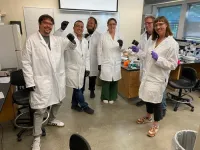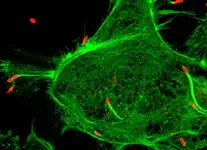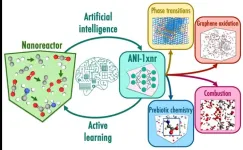(Press-News.org) *This is an early press release from the European Congress on Obesity (ECO 2024) Venice 12-15 May. Please credit the Congress if using this material*
New research being presented at this year’s European Congress on Obesity (ECO) in Venice, Italy (12-15 May), suggests that replacing sugar-sweetened food and drinks with low/no energy sweetened products can help weight control for at least one year after rapid weight loss in adults, without increasing the risk of type 2 diabetes or cardiovascular disease.
The findings of a year-long randomised controlled trial involving adults with overweight and obesity and children in the overweight range from Northern, Central and Southern Europe, also found that consumption of sweeteners and sweetness enhancers (S&SE) was associated with greater diet satisfaction, more positive mood, and less cravings and explicit liking for sweet foods in adults.
The results come in the wake of a 2023 systematic review of the evidence by WHO which suggested that replacing free sugars with non-sugar sweeteners did not appear to help with weight control in the long term, and could raise the risk of various health problems including type 2 diabetes and cardiovascular diseases, although the report highlighted uncertainty around the evidence between sweeteners and disease outcomes [1].
“Weight maintenance after weight loss is difficult to achieve, and our findings support the use of S&SEs found in many foods and beverages worldwide as alternatives to sugar-sweetened products to help manage weight control in adults with overweight”, says trial lead author Professor Anne Raben from the University of Copenhagen in Denmark. “The findings also provide important information to address the controversies about potential adverse health effects. Until now, safety data have generally come from animal studies using sweetener doses far above the usual intake in humans.”
S&SEs have very high sweetening power but contribute little or nothing to energy intake. Natural and synthesised sweeteners, such as aspartame, stevia, and saccharin, are commonly added to products by the food and drink industry to cut the sugar content, and are consumed by millions of people around the world every day, for example in soft drinks, desserts, and breakfast foods.
However, the safety of these food additives and their use in appetite and weight control has been hotly debated, and little is known about the long-term effects of S&SE on eating behaviour.
Sweeteners show promise for weight control
To provide more evidence, researchers from the SWEET (Sweeteners and sweetness enhancers: Prolonged effects on health, obesity and safety) project, conducted a one-year randomised controlled trial to investigate whether the prolonged use of S&SEs as part of a healthy low-sugar diet could improve weight loss maintenance after rapid weight loss, as well as benefit risk markers for type-2-diabetes and cardiovascular diseases compared to no S&SE consumption.
Participants also completed questionnaires (at the start of the trial and after 2, 6 and 12 months) to assess the effect of S&SEs on diet satisfaction, control overeating, explicit liking and implicit wanting for food, eating behaviour, physical activity, and quality of life.
The trial recruited 341 adults with overweight or obesity (aged 18-65 years, 71% women, body mass index (BMI) ≥25 kg/m2), and 38 children with overweight (6-12 years, 60% girls, BMI-for-age >85th percentile) from Denmark, Spain, Greece, and The Netherlands through web pages, social media, newspapers and registries.
During the first 2 months of the trial, adults were instructed to follow a low-energy diet (the Cambridge Weight Plan) with the aim of achieving at least 5% weight loss. Children received dietary advice to maintain body weight.
In the following 10 months, participants were randomised to either a healthy diet with less than 10% of energy from added sugar allowing for foods and drinks with S&SEs (S&SEs group), or a healthy diet with less than 10% of energy from added sugar not allowing foods and drinks with S&SEs (sugar group).
At the start of the trial and after 2, 6, and 12 months, participants took part in clinical investigation days to measure change in weight, in BMI-for-age z-score in children (a measure of how many standard deviations a child’s BMI is above or below the average BMI for their age and sex), anthropometry, and risk markers for T2D (e.g., glucose and haemoglobin A1c) and CVD (e.g., cholesterol). Participants also completed food frequency questionnaires and urine samples were collected to measure biomarkers of S&SEs, fructose and sucrose to measure compliance [2].
As planned, intake of sugar-rich foods and beverages declined in both groups over the trial, but significantly more in the S&SE than in the sugar group. At the same time, intake of S&SE products increased in the S&SE group and declined in the sugar group. These results were confirmed by urinary biomarker analyses.
The intention-to-treat analyses (including 277 adults who successfully lost 5% or more body weight after the 2-month weight loss period) found that those consuming S&SEs had slightly better weight loss maintenance after 1 year than the sugar group (average weight loss of -7.2kg vs -5.6 kg making a difference of 1.6 kg).
Additionally, in 203 participants who completed all clinical investigations, risk markers for type 2 diabetes and cardiovascular disease did not differ between the groups.
No differences in BMI-for-age z-score or other outcomes were noted in the 22 children who completed the trial. A larger study would be required in more children to determine any potential effect, researchers say.
Sweeteners reduce cravings for sweet foods and improve well-being in adults
In further analyses of eating behaviour, researchers found that adults in the S&SE group reported greater diet satisfaction when eating out, increased positive mood, and lower craving for sweet food at 6 months than the sugar group. In contrast, adults in the sugar group had greater liking for sweet over savoury foods at 6 months and 12 months. However, there were no differences between the groups in reported physical activity or quality of life.
In children, replacing food and drinks with added sugar with sweetened products had no impact on eating behaviour or physical activity. However, inclusion of S&SEs appeared to benefit children with high levels of uncontrolled eating (eating in response to food palatability [tastiness] and the likelihood of over-consuming).
As co-lead author Ms Clarissa Dakin from the Appetite Control and Energy Balance Research Group at the University of Leeds, UK, explains, “Our findings suggest that the inclusion of low/no energy sweetened products may benefit children who show high levels of uncontrolled eating. For these children, being allowed to consume S&SEs led to lower levels of uncontrolled eating at 12 months in comparison to the children who were not allowed to consume S&SE’s. This benefit was not found for children with lower levels of uncontrolled eating. Together, these findings provide important insights for the ongoing re-evaluation of food additive sweeteners by the European Food Safety Authority and other health agencies worldwide.”
Professor Jason Halford, Head of the School of Psychology at the University of Leeds, UK, one of the SWEET co-authors and President of the European Association for the Study of Obesity (EASO), says, “'The use of low calorie sweeteners in weight management has been questioned, in part because of the link between their use and apparent weight gain in observational studies, however, increasingly it is becoming apparent that is not the case in long term studies.”
The authors note that a key strength of the study is that it is a10-month (long-term) investigation which adds to the evidence of previous short-midterm trials by using a weight loss maintenance design, including both foods and drinks with S&SEs, and by using daily amounts of intervention products that are feasible and realistic in an every-day life. In addition, the trial was conducted as a multicentre trial in four countries across Europe.
Nevertheless, they note some limitations of the study, including that the drop-out rate was larger than estimated. However, with 203 completers, the statistical power for the primary outcome was 86%, which is deemed satisfactory. Additionally, they say that the children’s results should be interpreted with caution because of the small number of participants. Finally, they considered S&SEs collectively without distinguishing between individual types, although this was done intentionally to reflect the variation of products in the market. Selection bias may also have been a factor, as more participants were women, had higher educational levels, and exhibited health-conscious behaviours.
This research represents the core randomised trial of the SWEET project. Prof Jo Harrold (University of Liverpool, UK), one of the SWEET project co-ordinators explains, “The EU Horizon2020 funded project has been developing and reviewing evidence on the long-term benefits and potential risks of replacing added sugar in the diet with S&SEs from multiple perspectives. The results of this long term trial support the use of S&SEs instead of sugar in food and beverages to aid weight control. The evidence suggests there are no grounds for concern in regard to the safety of these products on sweet preference, appetite, or glucose control. These results add to the body of evidence which indicates that S&SEs can play a positive role in weight management when used judiciously. Other aspects of the project have alluded to barriers that impede the development of healthier, low-energy products and a resulting need to review policy and regulatory approaches. The SWEET symposium will offer an opportunity to make industry representatives, consumers and policy makers aware of the potential benefits of S&SEs for public health and safety, obesity and sustainability.”
END
Replacing sugar with sweeteners can improve weight loss control over the long-term in adults in the overweight range, finds European randomised controlled trial
European randomised controlled trial also finds that adults with overweight consuming food and drinks with no/low-energy sweeteners reported greater diet satisfaction, more positive mood, and lower cravings and explicit liking for sweet foods compared t
2024-03-21
ELSE PRESS RELEASES FROM THIS DATE:
Early registration opens for 2024 International Space Station Research and Development Conference in Boston
2024-03-21
BOSTON (MA), March 21, 2024 – This July, the 13th annual International Space Station Research and Development Conference (ISSRDC) returns to Boston, where leaders from the commercial sector, U.S. government agencies, and academic communities will assemble to highlight innovations and opportunities through our nation’s orbiting outpost. ISSRDC will take place July 30-August 1, 2024, at the Marriott Copley Place in Boston. Early registration is now open until May 24, 2024. Booking during early ...
Marine Biological Laboratory announces 2024 Logan Science Journalism Fellows
2024-03-21
WOODS HOLE, Mass. –Twelve accomplished science and health journalists have been awarded a highly competitive fellowship in the Logan Science Journalism Program at the Marine Biological Laboratory (MBL).
Now in its 37th year, the Logan Science Journalism Program provides journalists with immersive, hands-on research training, giving them invaluable insight into the practice of science as well as some of the major news stories of today. The program, which offers a Biomedical course and an Environmental course, will run May 13-23 in Woods Hole.
Biographies for the 2024 Logan Science Journalism Fellows are here. They are:
Biomedical Fellows
Pakinam Amer, Independent ...
Novel imaging platform allows researchers to study placental development in pregnant mice
2024-03-21
DURHAM, N.C. -- Physicians and biomedical engineers at Duke University have developed a method to visualize the growth of a placenta throughout a mouse’s pregnancy. By coupling an implantable window with ultrafast imaging tools, the approach provides the first opportunity to track placental development to better understand how the organ functions during pregnancy.
This new perspective gives researchers a precise way to examine how lifestyle factors like alcohol consumption and health complications like inflammation can affect the placenta and potentially lead to adverse pregnancy outcomes.
The research appears March 20 as the cover ...
AMS Science Preview: “Outdoor days,” lightning, air pollution
2024-03-21
The American Meteorological Society continuously publishes research on climate, weather, and water in its 12 journals. Many of these articles are available for early online access–they are peer-reviewed, but not yet in their final published form.
Below is a selection of articles published early online recently. To view full article text, members of the media can contact kpflaumer@ametsoc.org for press login credentials.
Observed Changes in Extreme Precipitation Associated with United States Tropical Cyclones
Journal of Climate
Rainfall ...
Illinois study: Systematic review of agricultural injuries can help inform safety measures
2024-03-21
URBANA, Ill. – Agricultural occupations are hazardous with one of the highest rates of workplace injuries and fatalities in the U.S. The manual and often strenuous nature of the work, combined with the use of machinery and exposure to environmental hazards create a challenging work environment. Understanding the nature and causes of injuries can help improve safety guidelines and policy measures. However, obtaining a comprehensive overview of injuries is hindered by the absence of a central reporting system. Two ...
New vaccine against a highly fatal tropical disease – and potential bioterror weapon – demonstrates efficacy in animal studies
2024-03-21
In a mouse study, UCLA researchers tested a vaccine against the bacterium that causes melioidosis and found it was highly protective against the disease, which is endemic in many tropical areas, causing approximately 165,000 cases with 89,000 fatalities around the world each year.
The bacterium, called Burkholderia pseudomallei, is spread through contact with contaminated soil and water through inhalation, ingestion or broken skin. It is so dangerous that it is categorized as a Tier 1 Select Agent of bioterrorism, and it can cause ...
Artificial intelligence helps explore chemistry frontiers
2024-03-21
The ability to simulate the behavior of systems at the atomic level represents a powerful tool for everything from drug design to materials discovery. A team led by Los Alamos National Laboratory researchers has developed machine learning interatomic potentials that predict molecular energies and forces acting on atoms, enabling simulations that save time and expense compared with existing computational methods.
“Machine learning potentials increasingly offer an effective alternative to computationally ...
UMass Amherst engineers create bioelectronic mesh capable of growing with cardiac tissues for comprehensive heart monitoring
2024-03-21
AMHERST, Mass. – A team of engineers led by the University of Massachusetts Amherst and including colleagues from the Massachusetts Institute of Technology (MIT) recently announced in the journal Nature Communications that they had successfully built a tissue-like bioelectronic mesh system integrated with an array of atom-thin graphene sensors that can simultaneously measure both the electrical signal and the physical movement of cells in lab-grown human cardiac tissue. In a research first, this tissue-like mesh can grow along with the cardiac cells, ...
Researchers take major step toward developing next-generation solar cells
2024-03-21
The solar energy world is ready for a revolution. Scientists are racing to develop a new type of solar cell using materials that can convert electricity more efficiently than today’s panels.
In a new paper published February 26 in the journal Nature Energy, a University of Colorado Boulder researcher and his international collaborators unveiled an innovative method to manufacture the new solar cells, known as perovskite cells, an achievement critical for the commercialization of what ...
CUNY ISPH to launch next phase of community-based cohort study to track short- and long-term effects of multiple respiratory viruses
2024-03-21
The City University of New York (CUNY) Institute for Implementation Science in Population Health (ISPH) and the CUNY Graduate School of Public Health and Health Policy (CUNY SPH), in collaboration with Pfizer, are initiating a critical two-year prospective epidemiologic study in the spring of 2024 to track acute respiratory infections across the United States.
Project PROTECTS (Prospective Respiratory Outcomes from Tracking and Evaluating Community-based TeSting) builds on the CHASING COVID Cohort Study, which has monitored SARS-CoV-2 infection rates and ...
LAST 30 PRESS RELEASES:
Victoria’s Secret grant backs cutting-edge ovarian cancer research
Research paves the way for safer colonoscopy bowel prep for people with compromised gut health
JMIR Publications and Sweden's National Library announce renewal and expansion of flat-fee unlimited open access partnership for 2026
A new 3D-printed solar cell that’s transparent and color-tunable
IV iron is the cost-effective treatment for women with iron deficiency anemia and heavy menstrual bleeding
Doing good pays off: Environmentally and socially responsible companies drive value and market efficiency
City of Hope and Cellares to automate manufacturing of solid tumor CAR T cell therapy
Short-circuiting pancreatic cancer
Groundbreaking mapping: how many ghost particles all the Milky Way’s stars send towards Earth
JBNU researchers propose hierarchical porous copper nanosheet-based triboelectric nanogenerators
A high-protein diet can defeat cholera infection
A more accurate way of calculating the value of a healthy year of life
What causes some people’s gut microbes to produce high alcohol levels?
Global study reveals widespread burning of plastic for heating and cooking
MIT study shows pills that communicate from the stomach could improve medication adherence
Searching for the centromere: diversity in pathways key for cell division
Behind nature’s blueprints
Researchers search for why some people’s gut microbes produce high alcohol levels
Researchers find promising new way to boost the immune response to cancer
Coffee as a staining agent substitute in electron microscopy
Revealing the diversity of olfactory receptors in hagfish and its implications for early vertebrate evolution
Development of an ultrasonic sensor capable of cuffless, non-invasive blood pressure measurement
Longer treatment with medications for opioid use disorder is associated with greater probability of survival
Strategy over morality can help conservation campaigns reduce ivory demand, research shows
Rising temperatures reshape microbial carbon cycling during animal carcass decomposition in water
Achieving ultra-low-power explosive jumps via locust bio-hybrid muscle actuators
Plant-derived phenolic acids revive the power of tetracycline against drug-resistant bacteria
Cooperation: A costly affair in bacterial social behaviour?
Viruses in wastewater: Silent drivers of pollution removal and antibiotic resistance
Sub-iethal water disinfection may accelerate the spread of antibiotic resistance
[Press-News.org] Replacing sugar with sweeteners can improve weight loss control over the long-term in adults in the overweight range, finds European randomised controlled trialEuropean randomised controlled trial also finds that adults with overweight consuming food and drinks with no/low-energy sweeteners reported greater diet satisfaction, more positive mood, and lower cravings and explicit liking for sweet foods compared t





